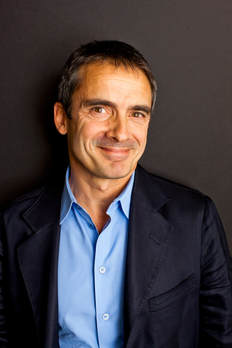
STEPHEN GALLOWAY is an Emmy Award-winning journalist who serves as the executive features editor for The Hollywood Reporter. Among his honors, he was named 2013 journalist of the year at the National Entertainment Journalism Awards. He has interviewed a who’s who of Hollywood including Steven Spielberg, Denzel Washington, Sean Penn, Brad Pitt and George Clooney. He also created the Reporter’s acclaimed roundtable series, featuring the likes of Peter Jackson, Quentin Tarantino, James Cameron, Sandra Bullock and Nicole Kidman. He is the author of LEADING LADY: SHERRY LANSING AND THE MAKING OF A HOLLYWOOD GROUNDBREAKER, which is currently available from Crown Archetype. We spoke recently about his book, Sherry's rise to power in a male-dominated industry from humble roots, and the cinematic moment that lives on more than seventy years after it appeared on film.
Dave Watson: First, congratulations on the book. Were there any surprises about Sherry’s life in writing it?
Stephen Galloway: Yes. Sometimes we look at very successful people and assume they just got there, that where they begin and where they end are one and the same place. That’s hardly ever the case. Sherry Lansing was a broken kid — or at least badly impacted by the early death of her father — and I had to find out how to chart the growth of this person who rose to become the most powerful woman Hollywood’s ever known.
DW: Like many of us, though, she had very strong parents, especially her mother.
SG: Her mother, Margot, was seventeen years old when she escaped Nazi Germany in 1938 and went on this extraordinary journey from Hamburg to New York to Chicago; she managed to create a new life for herself. Sherry learned how to navigate the world — and particularly the powerful men she would encounter in Hollywood — in going from her father, a rather charming, artistic and adoring man, to her stepfather, a tough businessman.
DW: But he also had a sensitive side. One theme in your book is that criticism or belittling comments by men don’t land on her.
SG: Their attacks somehow didn’t land on her. It wasn’t that she ignored them; it was more that she didn’t even notice what they were doing. Anger just didn’t bother her. These people got angry — they were tough guys, and they would unleash their vitriol on her, but what she understood was they were hurting inside. When she didn’t hit back, but just laughed or teased them, it disarmed them.
DW: What can other women learn from her? Especially if they work in a male-dominated industry?
SG: She never let the world around her define her. And also, her story shows any reader, male or female, that you can go from being a very fragile and insecure person and still remake yourself into something altogether different. She had things hard, just like anyone else at the beginning, especially in losing her father when she was eight.
DW: Your book balances the professional and the personal. Was this tough?
SG: Absolutely. I had to avoid the temptation to make this a sort of Wikipedia, just going from one of her films to another. She made 200 films at Paramount alone. Interweaving her filmmaking and her private journey was particularly difficult in that part, the Paramount years, which is 60 percent of the book.
DW: During her career, starting in the sixties and ending in the late 2000s, the industry changes dramatically. What’s her key to adaptation?
SG: She had a gut sense of what appealed to the public, as well as to her. She went with what she liked and was in- sync with the audience, the majority of the time. Second, she had a combination of strength and grace. She had the most velvet of gloves and the most steely of fists inside it.
DW: You showed that with her leveling a gaze at Alexander Payne when finishing the film Election, and it’s in contrast to who we get to know in the preceding pages.
SG: She could be tough when she had to, and also learned to be, and one of the interesting things about how the book has gone down is how many women respond to that and admire it.
DW: You start the book with her visit to Jimmy Carter. It’s a pivotal point. Why did you start there?
SG: It’s the moment of greatest suspense: should she stay in or leave the industry?
DW: It was an unusual trip for her, too. She went by herself, called Billy (Friedkin, her husband) from her hotel, got up the next morning and went to see the former president, who’s had a tremendous post-presidential career, probably the best ever after leaving office.
SG: I think so, too, and many would agree. The moment also tells readers that this book will be more than just a story inside the film business, and that we’re not just going to talk about contemporary Hollywood.
DW: And Hollywood can be a “now” and narrow industry.
SG: Very much. Sherry decided to give up her career and do something else.
DW: And she could just have put her feet up.
SG: She decided to go into the nonprofit world and create a whole new life at the age of sixty.
DW: Or go into politics, and she seems to do more for cancer and education outside the system. Finally, what is your favorite cinematic moment? One that inspires you to this day?
SG: It would be from Tokyo Story by Yasujiro Ozu, at the every end, when an old man says goodbye to his widowed daughter in-law. It is absolutely gut-wrenching. And yours?
DW: Funny, you are only the second person to ask! I would have to say, and this is much more mainstream, the jump to hyperspace in Star Wars. I have a few. Yours is from a film much heralded from a different time and place.
Clip: Tokyo Story

